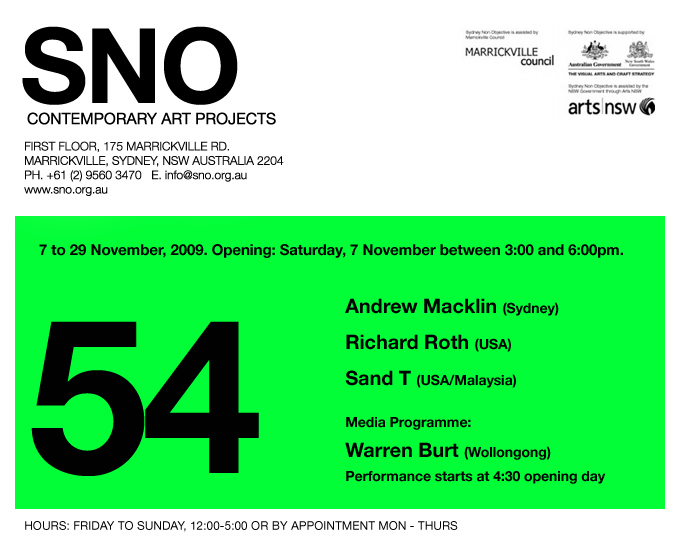THREE NEW VIDEO WORKS
 Sunday, November 29, 2009 at 10:13PM
Sunday, November 29, 2009 at 10:13PM I've just uploaded to YouTube three new video works of mine. Or maybe that should be three old video works of mine, rejigged.
Back in the summer of 1971, I did some experiments scratching on film, with the idea that they would become graphic scores for some kind of photocell-driven sound maker or graphics-to-sound conversion thing with a computer sometime in the future. I then filed them away, and promptly forgot about them. I just found them, and using Rasmus Eckman's free "Coagula" program, DID convert them to sound, and they're just what I was looking for. At the same time, Catherine sent me a little note using the "Pre-Columbino" font, (which uses pre Columbian type characters for letters) suggesting playfully that it could become a kind of "secret code" for us. I converted the Pre-Columbino characters, line by line, into white-on-black graphics, and converted them to sound with Coagula as well. I was delighted with the results of all this, so I decided to add the graphics to the soundtrack, making a little video out of it. Here are some of the graphics that started this all.

July 71 - hot pin on black slide film:

August 71 - hot pin on slide film roll ends.

November 2009 - a line from Catherine's "secret message," converted to white on black.
In the video, what you see is what you get - it's that simple, that literal. Each image is what produced the sound for that image, processed by Coagula. I'm so delighted with the results, that I'm going through my slides, looking for black ones, and black slide film, to do further work with this technique. Composing sound with a hot pin, and exposed film - seems like a fun idea to me!
Also back in 1970-71, when I was at the State University of New York at Albany, encouraged by the filmmaker / video artist Tom de Witt, I began experimenting with putting the output of the Moog synthesizer through an oscilloscope, making "Lissajous figure" graphics with it. There's more about this on the "My History with Music Technology" pages, but eventually, I made a piece with this technique, and several years later converted it to video. Today, I can only find a couple of stills from that piece - where the video master is, and how recoverable it is, I don't know. Here are the stills from "Starship" for electronic sound and video, which, as I remember, was 80 minutes long, and was designed to be an installation piece, whirling away in a corner of a gallery somewhere, which never happened.

Starship graphic 1.

Starship graphic 2
However, John Dunn's Artwonk 4.0 has a Lissajous module, so one can make real-time animated Lissajous figures with it. In the mid-70s, I also did some work with an oscilloscope, colorizing the results with an EMS Spectre Video Synthesizer, but never had access to an oscilloscope after that. Now, after 30+ years, I can return to using a technique I liked way back when. This short piece shows the new, more complex results that can now be made with this technique. The soundtrack is also produced by the Lissajous module. I took 2 stills from the video, converted them to sound with Rasmus Eckman's free "Coagula" program, and then put those into Camel Audio's Alchemy softsynth. I time-stretched them, and played a sequence of microtonal clusters with those sounds, and recorded that. So although sound and image are not in sync, they come from the same source. This piece is also an experiment to see how "fine-grained" computer graphics will look when compressed and put on YouTube. And although I think that a high-res version on a big screen might be nice, I'm actually quite pleased with the way that this version turned out.
Finally, LADEEZE AND GEMMMELMEN! for your edification, delight and amusement, we present a TRIPLE FEATURE (huzzah! huzzah!) of three VERY silly videos made with the mighty Intel Play video camera (cost $30US, 15 frames per second, low res) between 2004 and 2006. I've shown these privately to friends, just for grins, and now I share them with the world. Again, just for grins. Although, as the artist Donald Roller Wilson says (and he ought to know) "You can make a profound intellectual statement just by basing your efforts on silliness." All the videos were made very quickly. The last one was made, in fact, in about a half-hour after dinner one evening, to show our dinner guest, choreographer-director Anne O'Keeffe, how easy it was to use the camera and its built in software, stock music, and sound effects. And as one of the two crazed penguin-masked psycho-killers, Anne well and truly rose (or is that sunk?) to the spirit of the evening. Catherine Schieve's camera work is superb. She should get an Oxcart for cinematography! And my four other co-stars, Baby Wombat, Bluebearry, Chicken, and Mechanical Penguin, not to mention my film composer buddy Yellow Hippo, are bugging me as to when they're going to get their residuals from all this. And - here's one for the Zen scholars - what story from the "Blue Cliff Record" is referred to in the "foot scene" in "Bluebearry and Chicken's Zen Adventure." A no-prize for the correct answer. And if you taught Asian Art at York University in Toronto for 30+ years, you're ineligible to enter! Enjoy!
 Warren |
Warren | 



